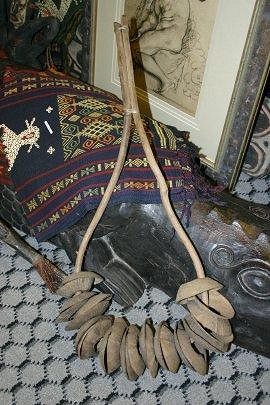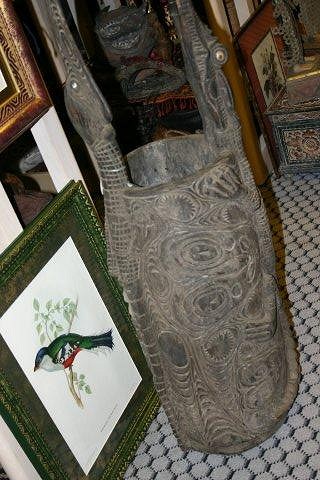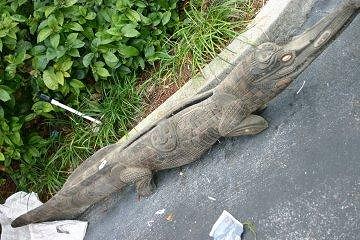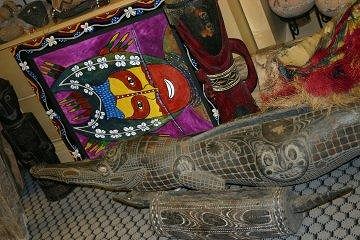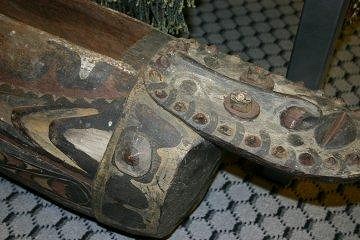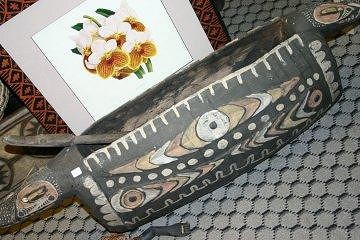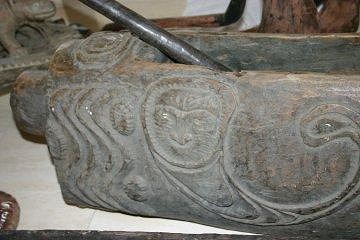Tiki Central / Collecting Tiki / Oceania, Etc: vendor of South Seas Art
Post #159713 by I dream of tiki on Tue, May 17, 2005 5:55 PM
|
IDOT

I dream of tiki
Posted
posted
on
Tue, May 17, 2005 5:55 PM
Musical Instruments
The community believes that the spirits of the ancestors reside in the shark body, especially the mako shark. And it was calling their ancestors that caused the shark to come. To awaken the spirits, the caller anoints himself and his canoe with secret herbs. Then he paddles out to the reef and symbolically spears the coral to arouse the spirit of Moro - the shark god. This done, he takes out a larung, a rattle fashioned out of bamboo and coconut shells, and begins shaking it in the sea which in fact create vibrations that attract sharks. Finally, he chants the age-old songs of the shark. If the shark answers the call, the hunter entices it to the side of his canoe and, softly stroking it, slips a loop of vine over its head. Then he clubs it to death.
"Water has had surprising prominence in the musical world. It has served as a tool, as inspiration, and even as a performing venue. Water Drums exist in various cultures. The native populations of the Americas constructed a drum within a drum, with the inner instrument being filled with various amounts of water to affect the timbre of the sound. In some areas in Africa and New Guinea, hollow gourds were placed in larger vessels and struck as well."
Slit gong drums known as garamuts are made of hollowed logs or tree trunks slit longitudinally along one side and beaten with sticks. Very large garamuts (up to 6 feet long) were used to summon people to war during head-hunting days, meetings, to pass messages to nearby villages, and to perform rituals. Medium-sized and smaller garamut drums are portable and can accompany performers to sing sings and cultural shows. The garamut as a means or form of non-verbal communication also made it possible for people to interpret certain messages being transmitted and also the interpretations of the sounds, codes and the different kinds of patterns of beats being performed or employed thus only well-skilled people handle the Garamut. Garamuts are kept in ceremonial houses and only men are allowed to play them. Garamuts are considered to have a spirit and they have names. They are powerful like masks and figures. They can kill people or make them sick. A garamut may take on other forms and walk at night. Garamuts are used in initiation ceremonies."
Mythology of the garamut: Sun carved slit-gong drums (garamut) from trees near the village, but none of them had a good sound. One night, Yirkaba changed herself into a tree and sent a leaf to tell Moon. Moon told Sun to hollow out a garamut from that tree. Sun cut a beautiful garamut from the tree. They named it Kabribuk, decorated it and brought it into the men's house in the village. It had a wonderful sound that carried very far. The splinters left from the drum became Yipwons. They lived as Sun's children, but stayed hidden in the men's house. One of Sun's relatives heard the drum, so he traveled to visit, but Sun was out hunting. The man went into the men's house to wait. The Yipwons tricked him and speared him as he looked into the garamut. He ran outside, but the Yipwons followed and killed him. They drank his blood and cut him to pieces. Moon was in a tree nearby picking leaves. She heard the noise and turned to see what was happening. The Yipwons realized they had been caught. They ran back into the men's house, stood against the wall and stretched up trying to look inconspicuous, stiff with fright. This is how they look today. When Sun returned and saw his dead relative, he was very angry. He decided to leave. The people returned, but too late to change his mind. He left them the Yipwon figures to bring magic spells for hunting and war. Then he climbed into the heavens, leaving the people in sadness. [ Edited by: I dream of tiki 2009-02-21 23:29 ] |

